Abstract
Cosmid clones containing 250 kilobases of genomic DNA from the human amylase gene cluster have been isolated. These clones contain seven distinct amylase genes which appear to comprise the complete multigene family. By sequence comparison with the cDNAs, we have identified two pancreatic amylase genes and three salivary amylase genes. Two truncated pseudogenes were also recovered. Intergenic distances of 17 to 22 kilobases separate the amylase gene copies. Within the past 10 million years, duplications, gene conversions, and unequal crossover events have resulted in a very high level of sequence similarity among human amylase gene copies. To identify sequence elements involved in tissue-specific expression and hormonal regulation, the promoter regions of the human amylase genes were sequenced and compared with those of the corresponding mouse genes. The promoters of the human and mouse pancreatic amylase genes are highly homologous between nucleotide -160 and the cap site. Two sequence elements thought to influence pancreas-specific expression of the rodent genes are present in the human genes. In contrast, similarity in the 5' flanking sequences of the salivary amylase genes is limited to several short sequence elements whose positions and orientations differ in the two species. Some of these sequence elements are also associated with other parotid-specific genes and may be involved in their tissue-specific expression. A glucocorticoid response element and a general enhancer element are closely associated in several of the amylase promoters.
Full text
PDF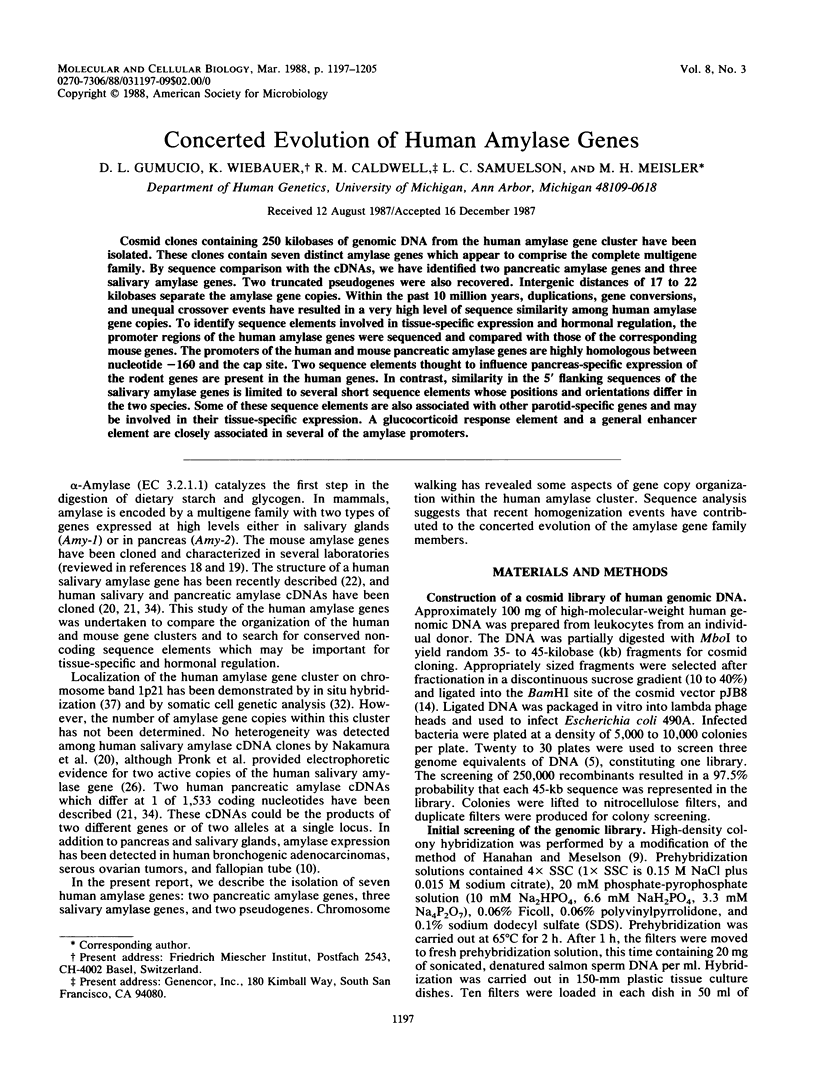
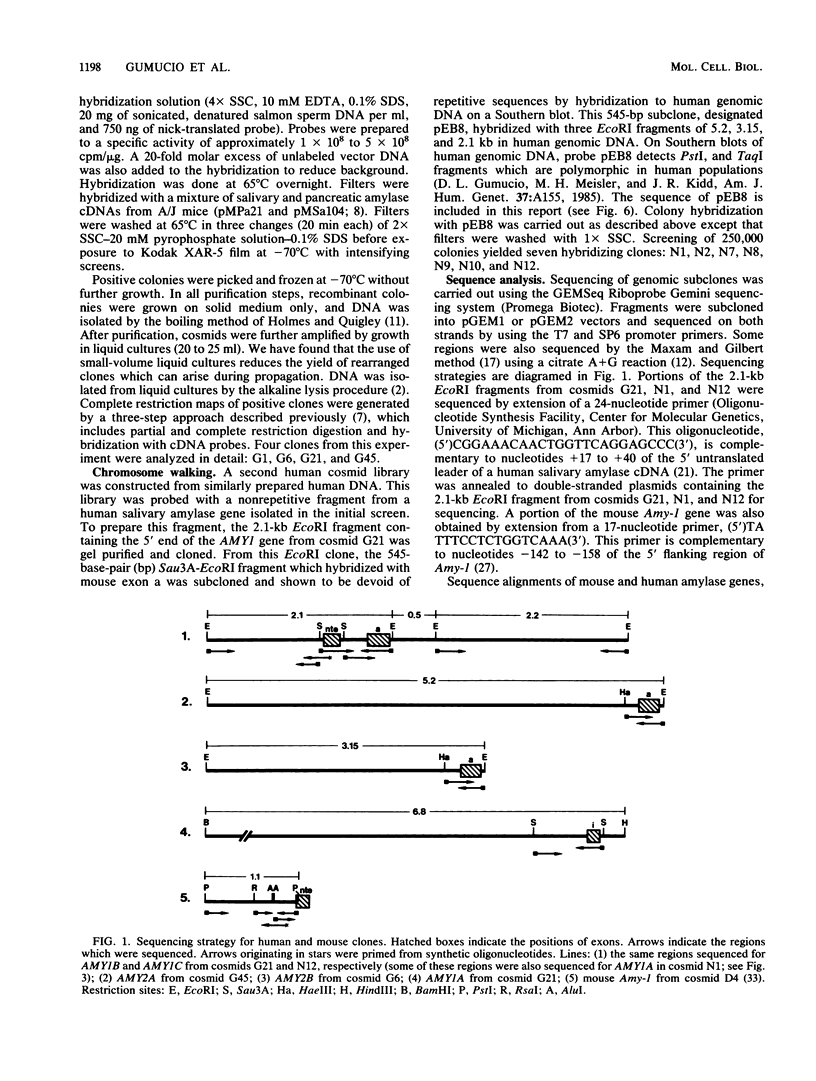

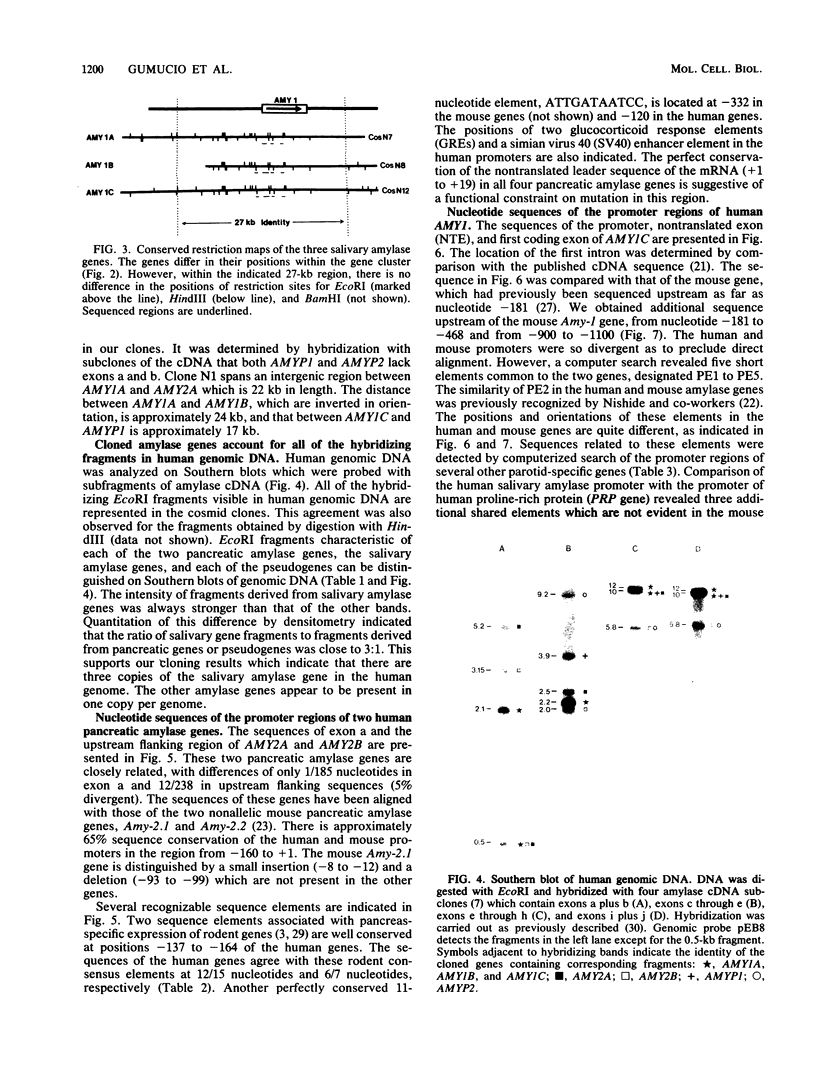
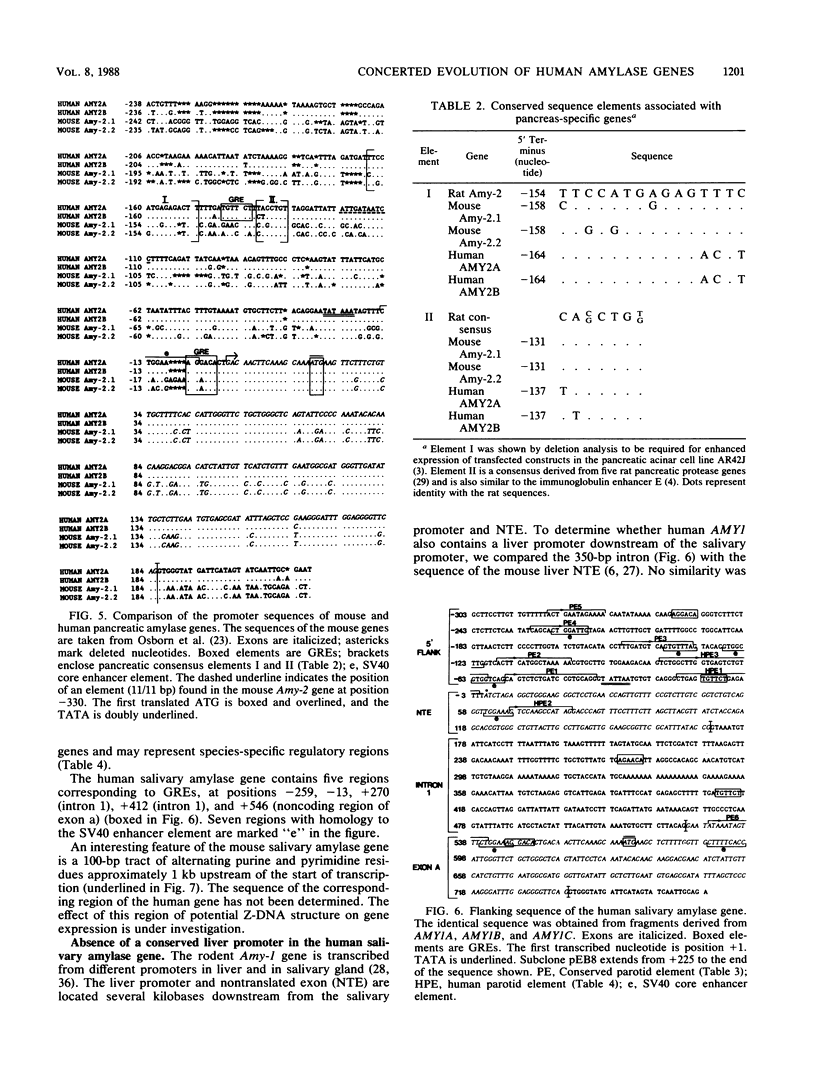

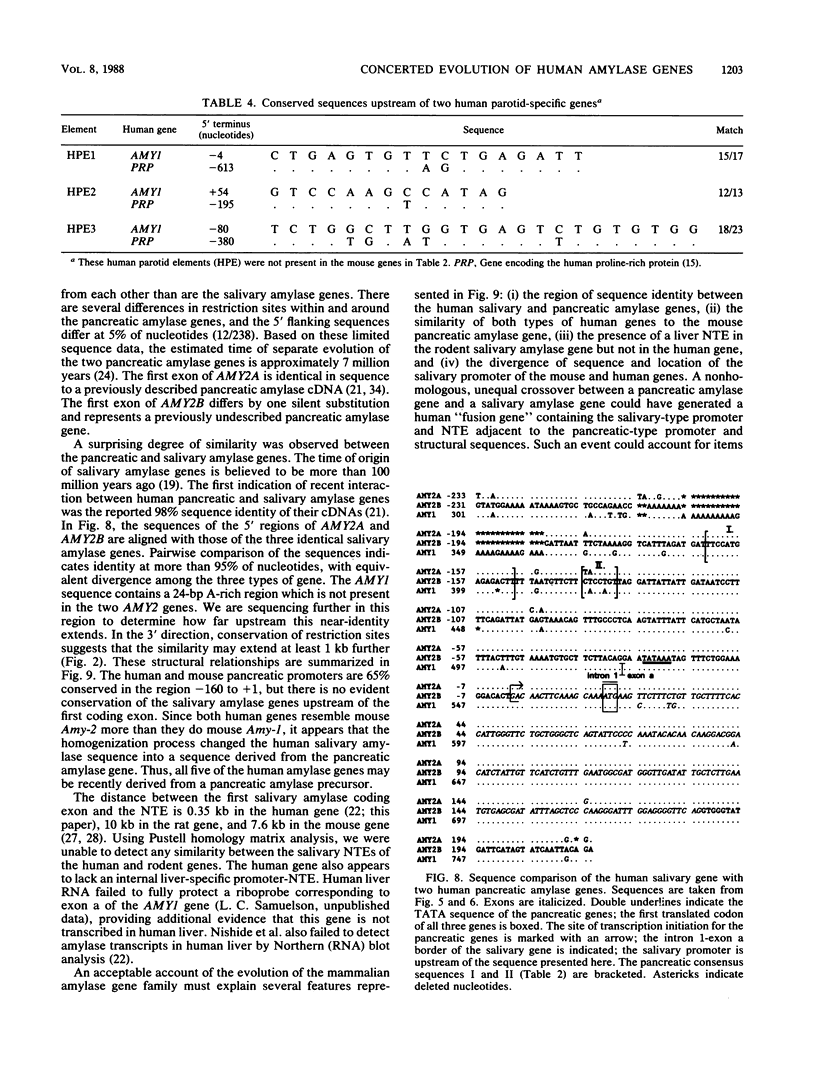
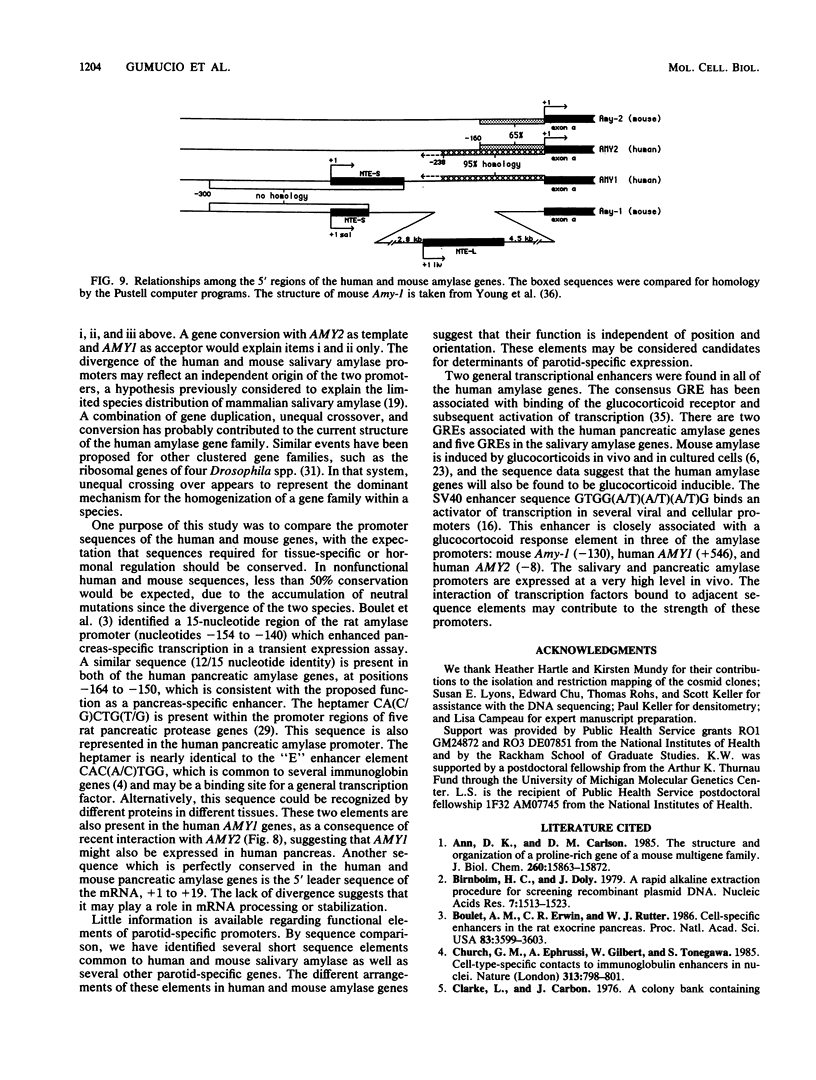
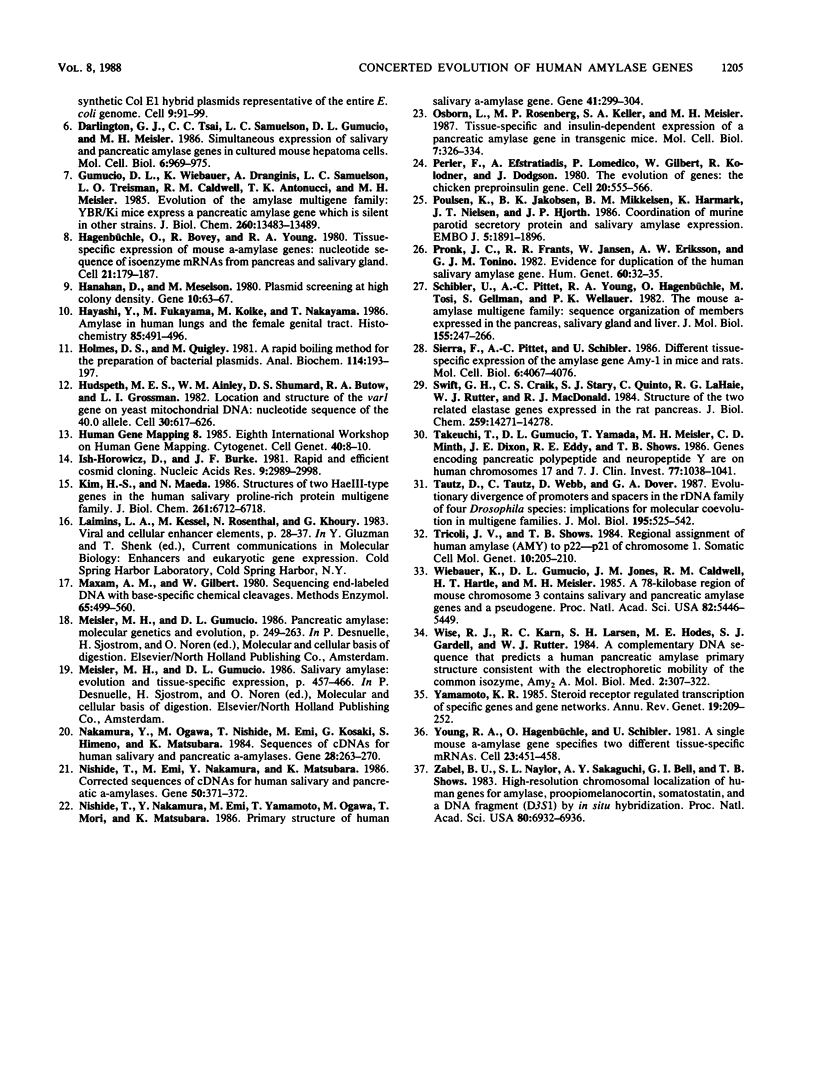
Images in this article
Selected References
These references are in PubMed. This may not be the complete list of references from this article.
- Ann D. K., Carlson D. M. The structure and organization of a proline-rich protein gene of a mouse multigene family. J Biol Chem. 1985 Dec 15;260(29):15863–15872. [PubMed] [Google Scholar]
- Birnboim H. C., Doly J. A rapid alkaline extraction procedure for screening recombinant plasmid DNA. Nucleic Acids Res. 1979 Nov 24;7(6):1513–1523. doi: 10.1093/nar/7.6.1513. [DOI] [PMC free article] [PubMed] [Google Scholar]
- Boulet A. M., Erwin C. R., Rutter W. J. Cell-specific enhancers in the rat exocrine pancreas. Proc Natl Acad Sci U S A. 1986 Jun;83(11):3599–3603. doi: 10.1073/pnas.83.11.3599. [DOI] [PMC free article] [PubMed] [Google Scholar]
- Church G. M., Ephrussi A., Gilbert W., Tonegawa S. Cell-type-specific contacts to immunoglobulin enhancers in nuclei. 1985 Feb 28-Mar 6Nature. 313(6005):798–801. doi: 10.1038/313798a0. [DOI] [PubMed] [Google Scholar]
- Clarke L., Carbon J. A colony bank containing synthetic Col El hybrid plasmids representative of the entire E. coli genome. Cell. 1976 Sep;9(1):91–99. doi: 10.1016/0092-8674(76)90055-6. [DOI] [PubMed] [Google Scholar]
- Darlington G. J., Tsai C. C., Samuelson L. C., Gumucio D. L., Meisler M. H. Simultaneous expression of salivary and pancreatic amylase genes in cultured mouse hepatoma cells. Mol Cell Biol. 1986 Apr;6(4):969–975. doi: 10.1128/mcb.6.4.969. [DOI] [PMC free article] [PubMed] [Google Scholar]
- Gumucio D. L., Wiebauer K., Dranginis A., Samuelson L. C., Treisman L. O., Caldwell R. M., Antonucci T. K., Meisler M. H. Evolution of the amylase multigene family. YBR/Ki mice express a pancreatic amylase gene which is silent in other strains. J Biol Chem. 1985 Nov 5;260(25):13483–13489. [PubMed] [Google Scholar]
- Hagenbüchle O., Bovey R., Young R. A. Tissue-specific expression of mouse-alpha-amylase genes: nucleotide sequence of isoenzyme mRNAs from pancreas and salivary gland. Cell. 1980 Aug;21(1):179–187. doi: 10.1016/0092-8674(80)90125-7. [DOI] [PubMed] [Google Scholar]
- Hanahan D., Meselson M. Plasmid screening at high colony density. Gene. 1980 Jun;10(1):63–67. doi: 10.1016/0378-1119(80)90144-4. [DOI] [PubMed] [Google Scholar]
- Hayashi Y., Fukayama M., Koike M., Nakayama T. Amylase in human lungs and the female genital tract. Histochemical and immunohistochemical localization. Histochemistry. 1986;85(6):491–496. doi: 10.1007/BF00508431. [DOI] [PubMed] [Google Scholar]
- Holmes D. S., Quigley M. A rapid boiling method for the preparation of bacterial plasmids. Anal Biochem. 1981 Jun;114(1):193–197. doi: 10.1016/0003-2697(81)90473-5. [DOI] [PubMed] [Google Scholar]
- Hudspeth M. E., Ainley W. M., Shumard D. S., Butow R. A., Grossman L. I. Location and structure of the var1 gene on yeast mitochondrial DNA: nucleotide sequence of the 40.0 allele. Cell. 1982 Sep;30(2):617–626. doi: 10.1016/0092-8674(82)90258-6. [DOI] [PubMed] [Google Scholar]
- Ish-Horowicz D., Burke J. F. Rapid and efficient cosmid cloning. Nucleic Acids Res. 1981 Jul 10;9(13):2989–2998. doi: 10.1093/nar/9.13.2989. [DOI] [PMC free article] [PubMed] [Google Scholar]
- Kim H. S., Maeda N. Structures of two HaeIII-type genes in the human salivary proline-rich protein multigene family. J Biol Chem. 1986 May 25;261(15):6712–6718. [PubMed] [Google Scholar]
- Maxam A. M., Gilbert W. Sequencing end-labeled DNA with base-specific chemical cleavages. Methods Enzymol. 1980;65(1):499–560. doi: 10.1016/s0076-6879(80)65059-9. [DOI] [PubMed] [Google Scholar]
- Nishide T., Emi M., Nakamura Y., Matsubara K. Corrected sequences of cDNAs for human salivary and pancreatic alpha-amylases [corrected]. Gene. 1984 May;28(2):263–270. doi: 10.1016/0378-1119(84)90265-8. [DOI] [PubMed] [Google Scholar]
- Nishide T., Nakamura Y., Emi M., Yamamoto T., Ogawa M., Mori T., Matsubara K. Primary structure of human salivary alpha-amylase gene. Gene. 1986;41(2-3):299–304. doi: 10.1016/0378-1119(86)90110-1. [DOI] [PubMed] [Google Scholar]
- Osborn L., Rosenberg M. P., Keller S. A., Meisler M. H. Tissue-specific and insulin-dependent expression of a pancreatic amylase gene in transgenic mice. Mol Cell Biol. 1987 Jan;7(1):326–334. doi: 10.1128/mcb.7.1.326. [DOI] [PMC free article] [PubMed] [Google Scholar]
- Perler F., Efstratiadis A., Lomedico P., Gilbert W., Kolodner R., Dodgson J. The evolution of genes: the chicken preproinsulin gene. Cell. 1980 Jun;20(2):555–566. doi: 10.1016/0092-8674(80)90641-8. [DOI] [PubMed] [Google Scholar]
- Poulsen K., Jakobsen B. K., Mikkelsen B. M., Harmark K., Nielsen J. T., Hjorth J. P. Coordination of murine parotid secretory protein and salivary amylase expression. EMBO J. 1986 Aug;5(8):1891–1896. doi: 10.1002/j.1460-2075.1986.tb04441.x. [DOI] [PMC free article] [PubMed] [Google Scholar]
- Pronk J. C., Frants R. R., Jansen W., Eriksson A. W., Tonino G. J. Evidence of duplication of the human salivary amylase gene. Hum Genet. 1982;60(1):32–35. doi: 10.1007/BF00281260. [DOI] [PubMed] [Google Scholar]
- Schibler U., Pittet A. C., Young R. A., Hagenbüchle O., Tosi M., Gellman S., Wellauer P. K. The mouse alpha-amylase multigene family. Sequence organization of members expressed in the pancreas, salivary gland and liver. J Mol Biol. 1982 Mar 5;155(3):247–266. doi: 10.1016/0022-2836(82)90004-3. [DOI] [PubMed] [Google Scholar]
- Sierra F., Pittet A. C., Schibler U. Different tissue-specific expression of the amylase gene Amy-1 in mice and rats. Mol Cell Biol. 1986 Nov;6(11):4067–4076. doi: 10.1128/mcb.6.11.4067. [DOI] [PMC free article] [PubMed] [Google Scholar]
- Swift G. H., Craik C. S., Stary S. J., Quinto C., Lahaie R. G., Rutter W. J., MacDonald R. J. Structure of the two related elastase genes expressed in the rat pancreas. J Biol Chem. 1984 Nov 25;259(22):14271–14278. [PubMed] [Google Scholar]
- Takeuchi T., Gumucio D. L., Yamada T., Meisler M. H., Minth C. D., Dixon J. E., Eddy R. E., Shows T. B. Genes encoding pancreatic polypeptide and neuropeptide Y are on human chromosomes 17 and 7. J Clin Invest. 1986 Mar;77(3):1038–1041. doi: 10.1172/JCI112357. [DOI] [PMC free article] [PubMed] [Google Scholar]
- Tautz D., Tautz C., Webb D., Dover G. A. Evolutionary divergence of promoters and spacers in the rDNA family of four Drosophila species. Implications for molecular coevolution in multigene families. J Mol Biol. 1987 Jun 5;195(3):525–542. doi: 10.1016/0022-2836(87)90181-1. [DOI] [PubMed] [Google Scholar]
- Tricoli J. V., Shows T. B. Regional assignment of human amylase (AMY) to p22----p21 of chromosome 1. Somat Cell Mol Genet. 1984 Mar;10(2):205–210. doi: 10.1007/BF01534909. [DOI] [PubMed] [Google Scholar]
- Wiebauer K., Gumucio D. L., Jones J. M., Caldwell R. M., Hartle H. T., Meisler M. H. A 78-kilobase region of mouse chromosome 3 contains salivary and pancreatic amylase genes and a pseudogene. Proc Natl Acad Sci U S A. 1985 Aug;82(16):5446–5449. doi: 10.1073/pnas.82.16.5446. [DOI] [PMC free article] [PubMed] [Google Scholar]
- Wise R. J., Karn R. C., Larsen S. H., Hodes M. E., Gardell S. J., Rutter W. J. A complementary DNA sequence that predicts a human pancreatic amylase primary structure consistent with the electrophoretic mobility of the common isozyme, Amy2 A. Mol Biol Med. 1984 Oct;2(5):307–322. [PubMed] [Google Scholar]
- Yamamoto K. R. Steroid receptor regulated transcription of specific genes and gene networks. Annu Rev Genet. 1985;19:209–252. doi: 10.1146/annurev.ge.19.120185.001233. [DOI] [PubMed] [Google Scholar]
- Young R. A., Hagenbüchle O., Schibler U. A single mouse alpha-amylase gene specifies two different tissue-specific mRNAs. Cell. 1981 Feb;23(2):451–458. doi: 10.1016/0092-8674(81)90140-9. [DOI] [PubMed] [Google Scholar]
- Zabel B. U., Naylor S. L., Sakaguchi A. Y., Bell G. I., Shows T. B. High-resolution chromosomal localization of human genes for amylase, proopiomelanocortin, somatostatin, and a DNA fragment (D3S1) by in situ hybridization. Proc Natl Acad Sci U S A. 1983 Nov;80(22):6932–6936. doi: 10.1073/pnas.80.22.6932. [DOI] [PMC free article] [PubMed] [Google Scholar]



